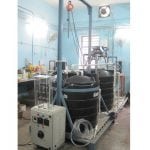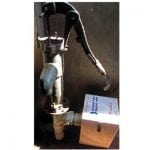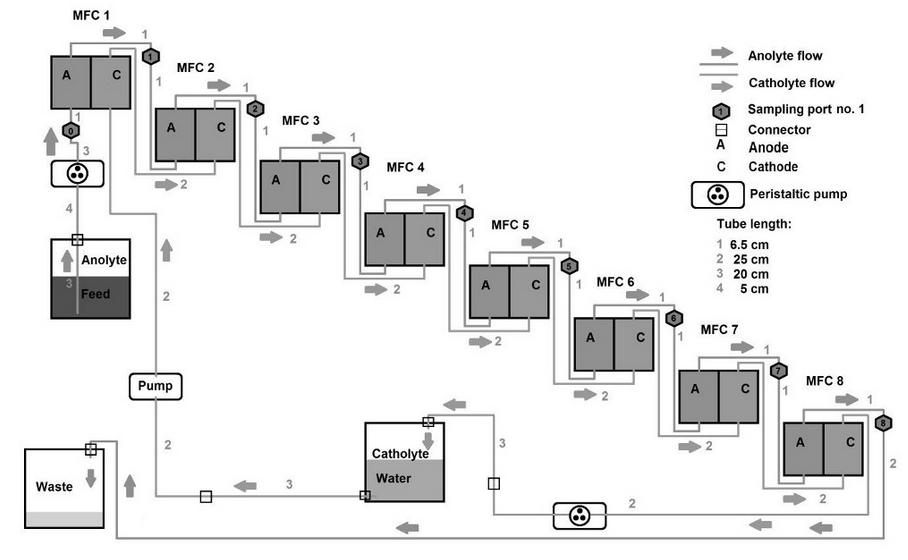From satellites peeping at water sources to “smart” latrines, new tools have emerged to help fix the problems with water and sanitation infrastructure in underserved communities. Government and global development practitioners have struggled for decades to provide clean water and working sanitation systems to the world’s hard-to-reach and impoverished regions. Practitioners have known that installing a village water pump is just a first step. The real challenge is to keep services and infrastructure working for the long term. That means maintaining pumps in working order long after they’re installed, ensuring that drinking water is truly treated and free of dangerous contaminants, servicing unsewered toilets, and so on.
One of the obstacles in long-term upkeep can be the simple ignorance of a problem. People don’t always know who to call when a pump breaks or a latrine fills, and the service providers don’t know when they’re needed. Now, new remote sensing solutions are removing some of the mystery from water and sanitation services for the global poor.
Evan Thomas presents the recorded E4C Webinar (above), Improving Water and Energy Service Delivery with Internet-of-Things Solutions. in it, Dr. Thomas, an Associate Professor at Portland State University and Director of the SweetLab, explains advances in remote sensing and Internet-connected devices that alert service providers when attention is needed.
Dr. Thomas and colleagues wrote a book on the topic, recently published by the World Bank, Innovations in WASH Impact Measures: Water and Sanitation Measurement Technologies and Practices to Inform the Sustainable Development Goals. These are excerpts from chapter five, Sensing WASH—In Situ and Remote Sensing Technologies. For an more in-depth exploration of the topic, including citations, please see the link above.
Sensing WASH—In Situ and Remote Sensing Technologies
The resilience of water and sanitation services is dependent upon credible and continuous indicators of reliability, leveraged by funding agencies to incentivize performance among service providers. Remote monitoring, via satellite assets and in situ sensors, may offer some contribution to addressing some of the challenges of information asymmetry and data gaps in developing communities including unreliable survey data and relying on spot checks to assess performance.
Satellite Remote Sensing Solutions
A variety of satellite data products have been leveraged to aid water and sanitation programs. Key examples include the following:
Landsat 8 launched in 2013, an Earth-observation satellite managed by the US National Aeronautics and Space Administration (NASA) and the US Geological Survey. It has two primary instruments, the Operational Land Imager (visible, near infrared [IR] and shortwave IR) and the Thermal Infrared Sensor (TIRS). Landsat 8 covers every point on Earth every 16 days, and has a resolution of 15–100 meters. Remote sensing experts can use its measurements for planning-level estimation of watershed health across a broad region. Additionally, land use classification can identify rural versus urban built environment and population density.
SERVIR, an initiative of NASA and the US Agency for International Development (USAID), helps developing countries use satellite information for managing climate risks and land use. SERVIR takes advantage of Landsat, ASTER, MODIS (Moderate Resolution Imaging Spectroradiometer), and other satellite assets to monitor water quality and changes.
Using Tropic Rainfall Measuring Mission data, the Nile Basin Initiative in partnership with NASA provides flood forecasts and water balance estimates for the Eastern Nile basin.
The Land Surface Hydrology Group at Princeton University developed the Africa Drought Monitor and provides maps of rainfall, temperature, and other hydrologic variables.
The USAID Famine Early Warning System Network (FEWS NET) monitors rainfall and crop production with satellite assets and combines these data with socioeconomic insights to identify population groups that may be vulnerable to food insecurity.
NASA’s Terra satellite includes two instruments that have been leveraged for watershed monitoring. MODIS and the Multiangle Imaging Spectroradiometer satellite assets can be used to determine aerosol optical depth, land surface temperature, enhanced vegetation index, and middle IR reflectance. Some of these data can be used to assess water quality parameters including chlorophyll, cyanobacterial pigments, colored dissolved organic matter, and suspended matter on a large water body scale.
In Nigeria, the World Bank recently used geographic information system mapping techniques to compare household survey data against MODIS land use estimates to generate spatial distribution estimates of water and sanitation indicators, including water and sanitation service access (World Bank 2017).
The Inter-American Development Bank (IDB) developed the Hydro-BID platform to assist countries in Latin America and the Caribbean with water management through the mapping and tracking of over 230,000 water catchment areas. The Hydro-BID platform is leveraged by government agencies and water utilities for regional water management and infrastructure planning.
Unmanned Aerial Vehicles
Increasingly, researchers are using unmanned aerial vehicles (UAVs, or drones) to map watersheds. The technological development of UAVs and their ability to derive high-resolution three-dimensional information at a much lower operational and up-front cost than manned airborne platforms and satellite imaging has made UAV image acquisition appealing in several applications.
Research applications using UAVs for environmental monitoring, management, and evaluation have been increasingly explored in the past 10 years. The use of UAVs for data collection in natural resource, biomass, forest, and vegetation monitoring has been found to have significant impacts on the temporal and spatial resolution of data at a more cost-effective price than traditional monitoring practices.
In Situ Sensors
In situ instrumentation varies from flow meters and water quality sensors to motion detectors installed in latrines. These sensor technologies can be used operationally or within a statistical sampling frame. Data can be logged locally for manual retrieval or transmitted over short range to nearby enumerators, or to remote operators and researchers over Wi-Fi, cellular, satellite, and other wireless networks.
Some instrumentation is in common use, whereas other technologies are emerging. However, given the remote and power-constrained environments and the high degree of variability between fixed infrastructure including age, materials, quality, servicing, and functionality, any electronic sensor–based solution often either is custom engineering or compensates for these complexities through analytics. For example, a conventional flow meter designed for a rural borehole water distribution scheme would have to address pipe diameter, material, pressure, depth, thread type, and other characteristics that require custom engineering and plumbing. Instead, a nonintrusive ultrasonic flow meter may be more easily adapted for a variety of water schemes.
Water Quality Sensors
Several water quality sensors are commonly used for both in situ continuous monitoring and sample-based testing. Off-the-shelf sensors are readily available to measure pH, dissolved oxygen, conductivity (often used to measure salinity), turbidity, temperature, chlorine, and various dissolved ions including fluoride, ammonia, silver, nitrates and nitrites (often byproducts of fertilizers), and total organic carbon.
Recent sensor applications that are directly relevant to Sustainable Development Goal (SDG) targets 6.1 and 6.2 monitoring, are highlighted below.
Microbial Sensors
A class of optical fluorimeters offers a potential for real-time in situ fecal contamination detection. These sensors detect tryptophan-like fluorescence (TLF) associated with the presence of microbial contamination. In recent years, several laboratory-grade products have been validated in the field as predictive of Escherichia coli (E. coli). However, these instruments require frequent cleaning, are not intended for long-term autonomous operation, and cost $7,500 or more. These state-of-the-art fluorimeter solutions are not designed for long-term invsitu use, primarily because of biofouling and baseline drift that attenuate and ambiguate the signal.
Optical fluorimeters offer a potential for real-time in situ fecal contamination detection, but they are expensive and not indended for long-term operation.
At present, there are no viable in situ electronic sensors for monitoring microbial contamination of drinking water. The closest products suitable for this application are spectroscopy-based sensors for TLF from E. coli. The United Nations Children’s Fund has recently published a Target Product Profile detailing a market need for improved sensor systems for microbial contamination in drinking water (UNICEF 2014).
Chemical Sensors
There are several commercially available sensors for fluoride monitoring, a priority chemical constituent in some countries. They include the Hach sensION+ Fluoride Ion Electrode and various in-line sensors for larger-scale water distribution systems, such as the Rosemount Fluoride Monitoring System (Emerson Automated Solutions 2017), and the ATI Fluoride Monitor.
There remains a need for additional development in the detection of arsenic in drinking water.
In Bangladesh, where arsenic contamination is a priority contaminant affecting health, biosensors in development can be rapidly deployed to indicate arsenic in drinking water. Similarly, there are several off-the-shelf sensor-based technologies for monitoring arsenic contamination. These include the Palintest Digital Arsenic Test Kit and the IPI Digital Arsenic Detector. However, there remains a need for additional technology development in this area.
From E4C’s Solutions Library
ElectroChemical Arsenic Remediation (ECAR), by Gadgil Laboratory, University of California Berkeley
Multi-Parameter Sensors
Akvo Caddisfly builds on the smartphone-based application Akvo Flow. Currently, Akvo Caddisfly can measure several water quality parameters. Fluoride is measured by collecting water in a test chamber, adding a reagent to the sample, and taking a photo to analyze the concentration according to the color generated by the sample and reagent mixture. Salinity is measured with an electrical conductivity sensor attached directly to the phone via a USB cable. Additionally, any color-based test strip can be analyzed by Akvo Caddisfly automatically corresponding the test strip color to the color calibration card, thereby taking out any subjectivity on the part of the user.
Water Service Delivery and Use
In municipal water supplies in many cities, water flow meters are commonly used to measure service delivery and enable billing. These meters vary in functionality and form, from manually read mechanical meters to remotely reporting sensors. A challenge facing water service providers and customers is “non-revenue water” (NRW)—water that is produced but not billed for. In developing countries, NRW is estimated at more than $40 billion per year, losing enough water to serve 200 million people—45 billion liters—and a further 30 billion liters lost to poor metering or billing processes. This negative feedback loop diminishes the capacity of utilities to deliver reliable, safe water, and the willingness of customers to pay for this service.
Improved water meters and processes can reduce this NRW gap, and improve the quality and faith in water service delivery. In India, NextDrop Technologies has combined remotely reporting water meters with periodic water quality tests to reduce water consumption, leaks, and service outages.
Also in India, the social enterprise Piramal Sarvajal developed a reverse osmosis water treatment “ATM” (automated teller machine) that continuously monitors and remotely reports on system functionality and water quality.
“Smart” Hand Pumps
In Sub-Saharan Africa, about one million hand pumps supply water to over 200 million rural water users across the continent, yet as many as one-third of all hand pumps are thought not to be working at any given time, with 30–70 percent broken within two years. In 2013, Oxford University conducted trials on 66 mobile-enabled “smart hand pumps.” The study demonstrated that hand pumps with cellular network–enabled sensors that were repaired in the trial saw a decrease in pump downtime from an average of 27 days to 2.6 days. Participating communities also increased by over threefold their willingness to pay for pump services.
Sensors on pumps led to a repair time of 21 days and 91 percent functionality, compared to 214 days and 56 percent functionality at baseline.
Building on this work, in 2014, Portland State University and Living Water International installed 181 cellular-enabled water pump use sensors in three provinces of Rwanda. The nominal maintenance model was compared against a “best practice” circuit rider model, wherein dedicated staff and supplies were assigned to pump groups, and an “ambulance” service model wherein sensor data triggered a service dispatch. In only the ambulance model were the sensor data available to the implementer and used to dispatch technicians.
In the baseline, 56 percent of the implementer’s pumps were functional, with a mean reported nonfunctionality of approximately 214 days. In the study period, the nominal maintenance group had a median time to successful repair of approximately 152 days, with a mean per-pump functionality of about 68 percent. In the circuit rider group, the median time to successful repair was nearly 57 days, with a per-pump functionality mean of nearly 73 percent. In the ambulance service group the successful repair interval was nearly 21 days with a functionality mean of nearly 91 percent.
“Smart” Meters
Smart metering, an approach first matured in the power industry, allows a water utility to obtain meter readings on demand without requiring manual meter readers. A recent IDB report summarized the opportunities and limitations of smart water meters. Smart meters can benefit the water utility, the environment, and the utility’s customers by:
- Lowering the cost of meter reading
- Enhancing employee safety by reducing the number of people on the road
- Reducing billing errors and delays
- Monitoring the water system
- Providing useful data for balancing customer demand
- Enabling dynamic pricing (raising or lowering the cost of water according to demand)
- Enabling customers to adjust their habits to lower water bills
- Reducing customer complaint calls and increasing customer satisfaction
- Monitoring meter tampering and water theft
- Detecting water line leaks sooner so they can be repaired faster.
Although smart meters have many benefits, they also present challenges to water utilities, customers, and the environment. They require:
- Front-end capital investment and long-term financial commitment to the new technology
- Managing large quantities of metering data and ensuring its security, preventing cyberattacks
- Proper training
- Managing customer reaction to the new meters
- Disposing of the old meters
Household Water Treatment Use
Several products are available commercially to monitor residual chlorine, an indication of water treatment practices and water safety. These include pocket colorimeters from Hach, Analyticon, DKK-TOA, Omega, and other vendors.
The use of household water filters has also been measured in some studies. In Rwanda, a cluster randomized controlled trial was conducted among 170 households (70 blinded to the presence of the sensor, 100 open) testing whether awareness of an electronic monitor would result in a difference in weekly use of household water over a four-week surveillance period.
Water filter use rose by 63 percent in households where use was monitored electronically, then declined after four weeks.
A 63 percent increase in the number of uses of the water filter per week between the groups was observed in week 1, an average of 4.4 times in the open group and 2.83 times in the blind group, declining in week 4 to an insignificant 55 percent difference of 2.82 uses in the open, and 1.93 in the blind. Use of the water filters decreased in both groups over four-week installation periods. This study suggests behavioral monitoring should attempt to account for reactivity to awareness of electronic monitors that persists for weeks or more.
From E4C’s Solutions Library
Sanitation Use
The Passive Latrine Use Monitor (PLUM) is a motion detector–based sensor platform for estimating latrine use. PLUM was developed at
the University of California at Berkeley. The sensor uses a simple passive IR motion detector to identify warm-bodied movement in a
latrine stall. This binary movement data is recorded at three-second intervals, and either logged locally on the sensor device or transmitted by cellular or satellite data networks for online processing. Structured observation validated algorithms process this movement data into discrete use estimates. These estimates have been shown to be more reliable at individual households than in community latrines where lines may form. In some cases, the sensors include radio frequency identification readers to enable latrine-servicing requests, as demonstrated with Sanergy Inc., in Nairobi, Kenya.
In one recent study in Bangladesh, these sensors demonstrated a significant over-reporting of latrine use. Across 1207 households randomly selected from 52 village committees in Bangladesh, the mean four-day self-reported number of latrine uses was 32.8, whereas sensor analysis suggested 21.7 uses on average, indicating more than 50 percent exaggeration of latrine use. At the low end of the regression model, the intercept suggests that many households report using latrines when in fact no use is detected.
Similarly, in a recent cross-sectional study among 292 households in 25 villages in India, these sensors were installed for two weeks and compared to household responded surveys. The mean reported daily use was nearly twice that of the sensor-recorded use with moderate agreement between daily reported use over the past 48 hours.
Handwashing Monitoring
Sensors can also provide an objective and nonobtrusive characterization of handwashing behavior.
SmartSoap, developed by Unilever, is an ordinary looking bar of soap with an embedded accelerometer that measures motion on three axes, allowing the detection of use. On its own, SmartSoap can provide an accurate count of the number of times the soap bar is used each day. By combining SmartSoap data with data from a motion sensor placed on the vessel holding water for anal cleansing, researchers were able to detect handwashing events after defecation. Although overall soap use increased, they found that there was no increase in the number of soap uses following defecation.
Similarly, Mercy Corps used motion detector–based latrine sensors combined with water flow sensors to monitor the prevalence of handwashing after latrine use. They found that water use after latrine use was very low (less than 10 percent) in all but one district, which registered almost 40 percent use of water after latrine use. They also found that self-reported use of the latrine and handwashing after using the latrine was much greater (up to 4 times and 25 times, respectively) than the latrine use and handwashing after latrine use detected by the sensors.
This is an adaptation of an original work by The World Bank and the Inter-American Development Bank. Views and opinions expressed in the adaptation are the sole responsibility of the author or authors of the adaptation and are not endorsed by The World Bank or the Inter-American Development Bank.
Excerpts from Thomas, Evan, Luis Alberto Andrés, Christian Borja-Vega, and Germán Sturzenegger, eds. 2018. Innovations in WASH Impact Measures: Water and Sanitation Measurement Technologies and Practices to Inform the Sustainable Development Goals. Directions in Development. Washington, DC: World Bank. doi:10.1596/978-1-4648-1197-5.
License: Creative Commons Attribution CC BY 3.0 IGO




Great innovation
really a marvellous work